Founded in 1938 and published semiannually by Sophia University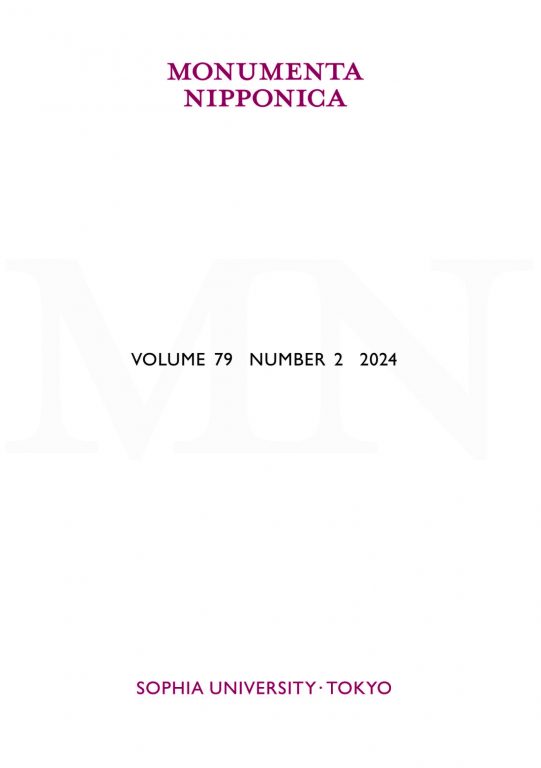 MN 79:2 (2024) 215–51Taming Dance in Meiji and Taishō Japan: Bon Dance Regulations, “Home Dance,” and the Creation of National CultureMargaret Mehl
MN 79:2 (2024) 215–51Taming Dance in Meiji and Taishō Japan: Bon Dance Regulations, “Home Dance,” and the Creation of National CultureMargaret Mehl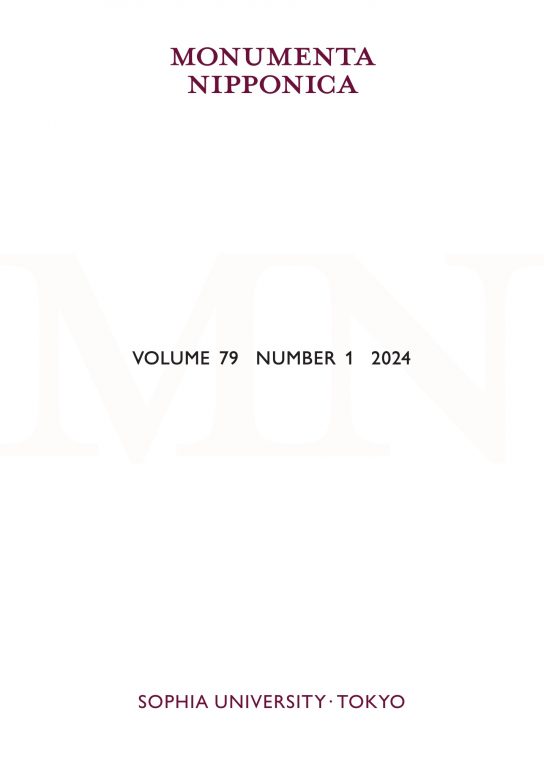 MN 79:1 (2024) 1–31Revisiting The Soil: Nagatsuka Takashi, Rural Japan, and the Limits of the Meiji NovelTyler Walker
MN 79:1 (2024) 1–31Revisiting The Soil: Nagatsuka Takashi, Rural Japan, and the Limits of the Meiji NovelTyler Walker MN 79:1 (2024) 33–82Overcoming Modernity, Exonerating Empire: Yoshimitsu Yoshihiko and the Ironies of Early Shōwa CatholicismChristopher T. Lough
MN 79:1 (2024) 33–82Overcoming Modernity, Exonerating Empire: Yoshimitsu Yoshihiko and the Ironies of Early Shōwa CatholicismChristopher T. Lough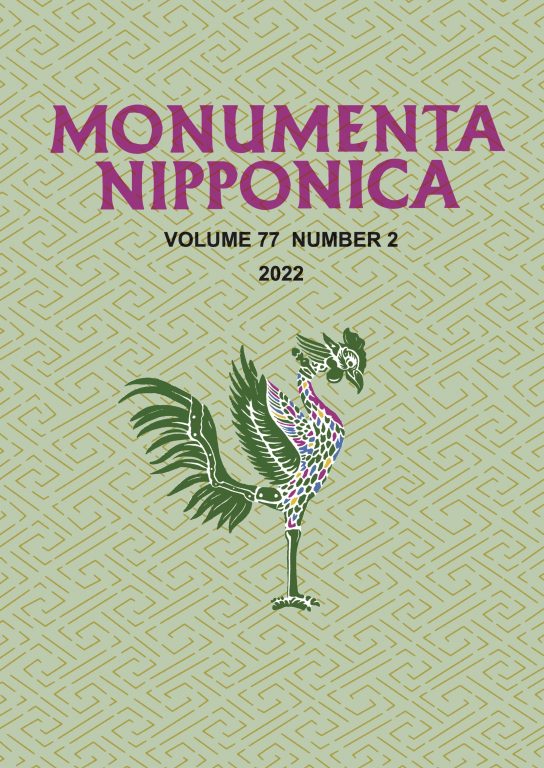 MN 77:2 (2022) 259–94The Self-Fashioning of E. S. Morse: A Comparison of Japan Day by Day and Its Primary SourceHina Hirayama
MN 77:2 (2022) 259–94The Self-Fashioning of E. S. Morse: A Comparison of Japan Day by Day and Its Primary SourceHina Hirayama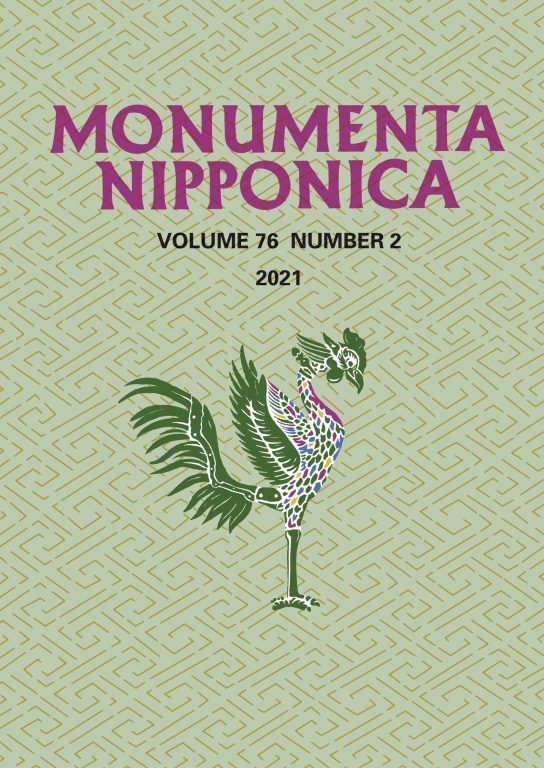 MN 76:2 (2021) 329–61The Small Vehicle: The Construction of Hinayana and Japan’s Modern BuddhismStephan Kigensan Licha
MN 76:2 (2021) 329–61The Small Vehicle: The Construction of Hinayana and Japan’s Modern BuddhismStephan Kigensan Licha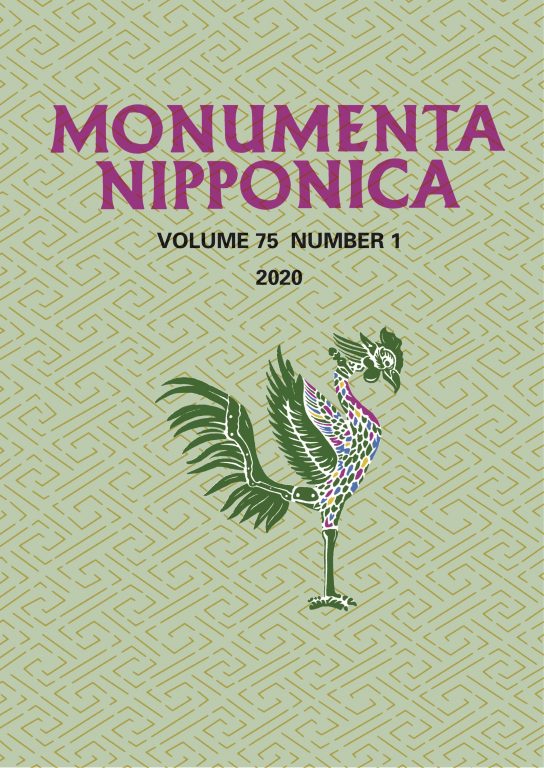 MN 75:1 (2020) 91–122The Massacre of Koreans in Yokohama in the Aftermath of the Great Kanto Earthquake of 1923Kenji Hasegawa
MN 75:1 (2020) 91–122The Massacre of Koreans in Yokohama in the Aftermath of the Great Kanto Earthquake of 1923Kenji Hasegawa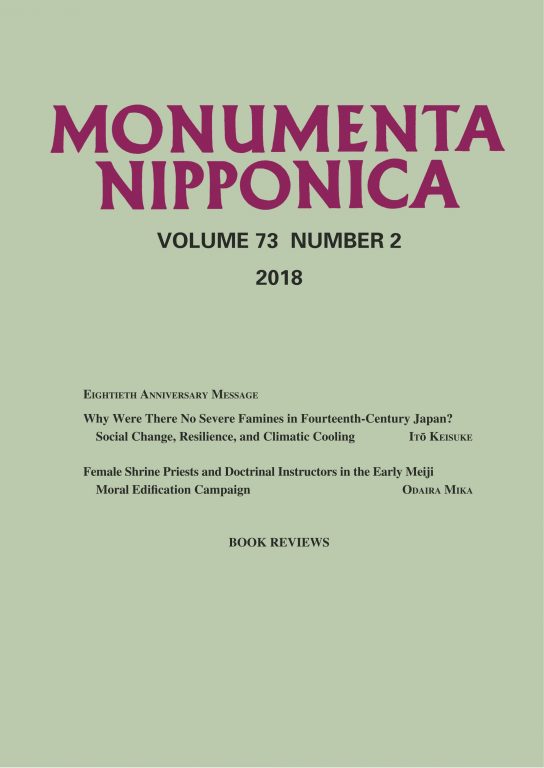 MN 73:2 (2018) 213–44Female Shrine Priests and Doctrinal Instructors in the Early Meiji Moral Edification CampaignMichael Burtscher and Mika Odaira
MN 73:2 (2018) 213–44Female Shrine Priests and Doctrinal Instructors in the Early Meiji Moral Edification CampaignMichael Burtscher and Mika Odaira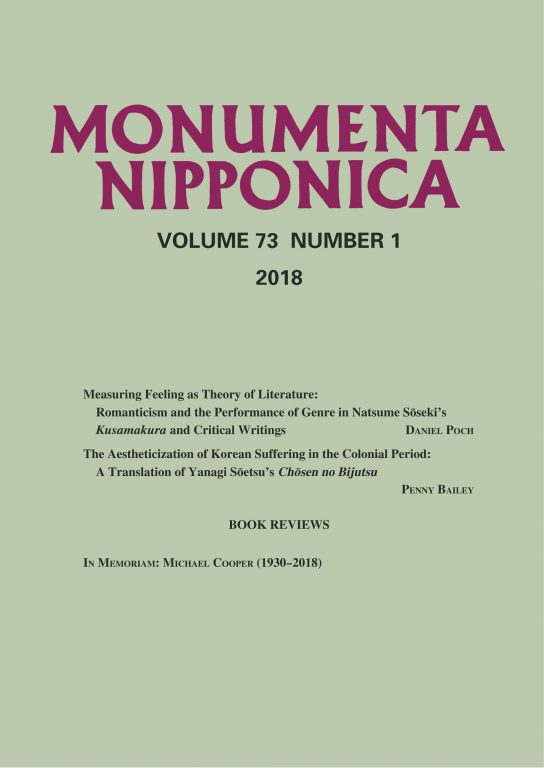 MN 73:1 (2018) 1–26Measuring Feeling as Theory of Literature: Romanticism and the Performance of Genre in Natsume Sōseki’s Kusamakura and Critical WritingsDaniel Poch
MN 73:1 (2018) 1–26Measuring Feeling as Theory of Literature: Romanticism and the Performance of Genre in Natsume Sōseki’s Kusamakura and Critical WritingsDaniel Poch MN 73:1 (2018) 27–85The Aestheticization of Korean Suffering in the Colonial Period: A Translation of Yanagi Sōetsu’s Chōsen no BijutsuPenny Bailey
MN 73:1 (2018) 27–85The Aestheticization of Korean Suffering in the Colonial Period: A Translation of Yanagi Sōetsu’s Chōsen no BijutsuPenny Bailey MN 73:1 (2018) 63–85Korean ArtSōetsu Yanagi, Translated by Penny Bailey
MN 73:1 (2018) 63–85Korean ArtSōetsu Yanagi, Translated by Penny Bailey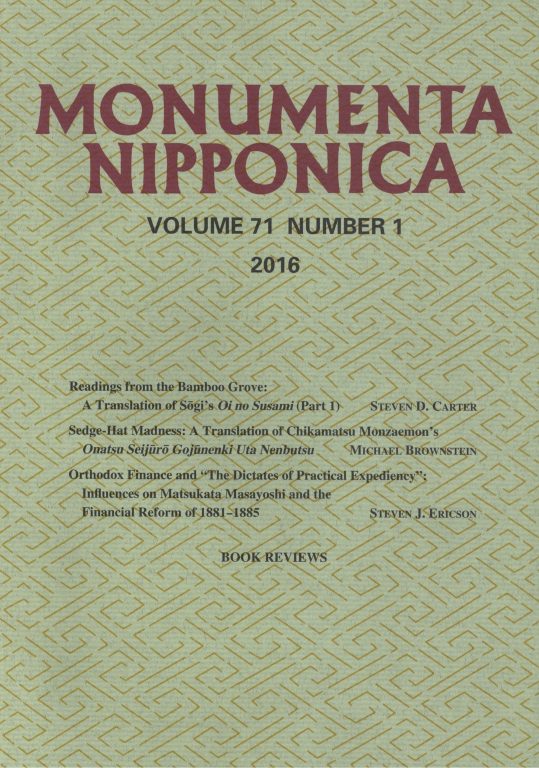 MN 71:1 (2016) 83–117Orthodox Finance and “The Dictates of Practical Expediency”: Influences on Matsukata Masayoshi and the Financial Reform of 1881–1885Steven J. Ericson
MN 71:1 (2016) 83–117Orthodox Finance and “The Dictates of Practical Expediency”: Influences on Matsukata Masayoshi and the Financial Reform of 1881–1885Steven J. Ericson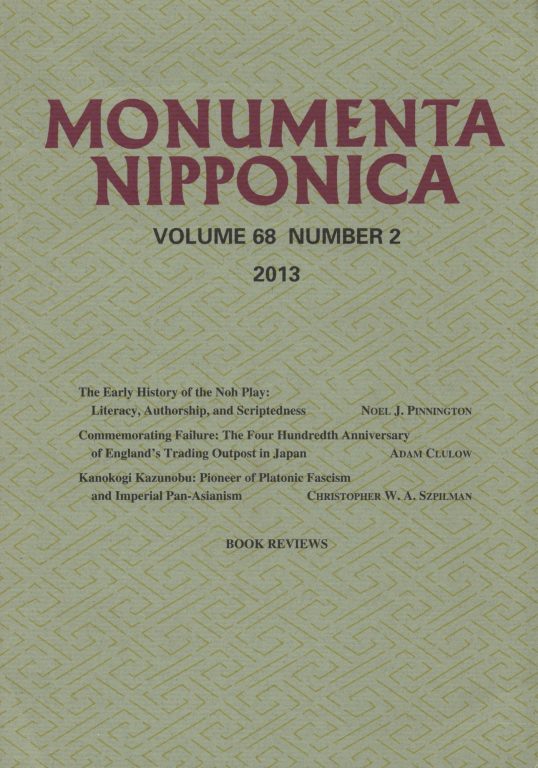 MN 68:2 (2013) 233–80Kanokogi Kazunobu: Pioneer of Platonic Fascism and Imperial Pan-AsianismChristopher W. A. Szpilman
MN 68:2 (2013) 233–80Kanokogi Kazunobu: Pioneer of Platonic Fascism and Imperial Pan-AsianismChristopher W. A. Szpilman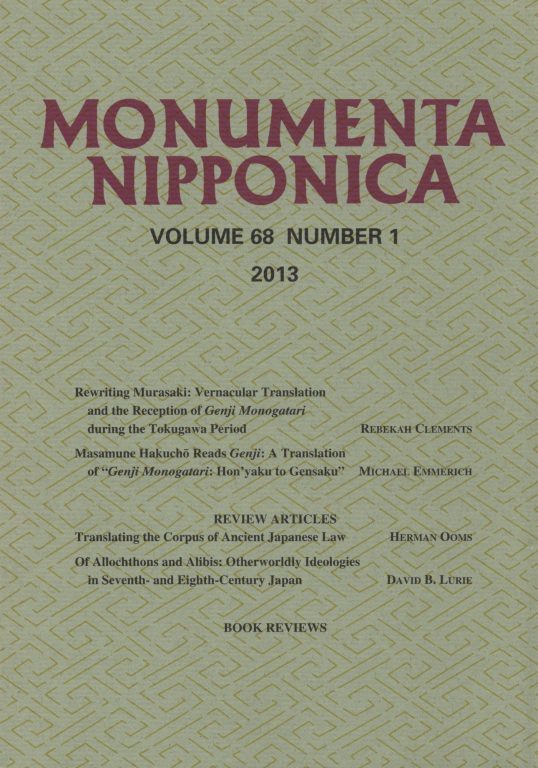 MN 68:1 (2013) 37–68Masamune Hakuchō Reads Genji: A Translation of “Genji Monogatari: Hon’yaku to Gensaku”Michael Emmerich
MN 68:1 (2013) 37–68Masamune Hakuchō Reads Genji: A Translation of “Genji Monogatari: Hon’yaku to Gensaku”Michael Emmerich MN 68:1 (2013) 53–68Genji Monogatari: Hon’yaku to GensakuMasamune Hakuchō , Translated by Michael Emmerich
MN 68:1 (2013) 53–68Genji Monogatari: Hon’yaku to GensakuMasamune Hakuchō , Translated by Michael Emmerich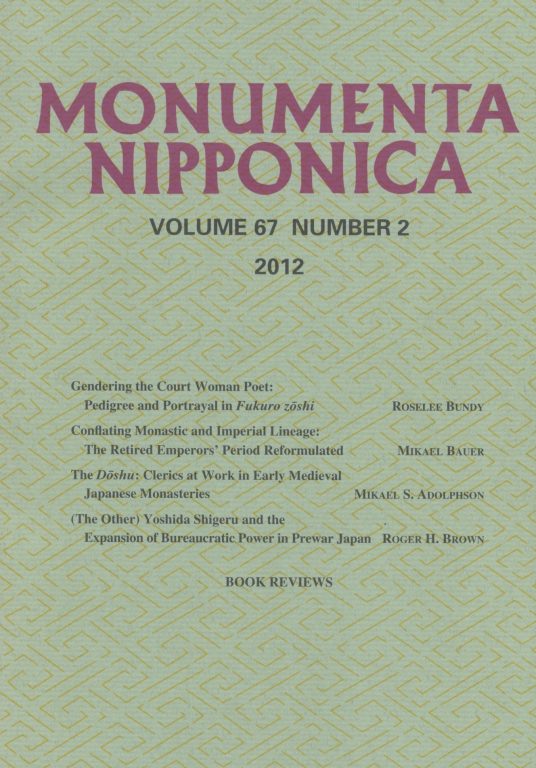 MN 67:2 (2012) 283–327(The Other) Yoshida Shigeru and the Expansion of Bureaucratic Power in Prewar JapanRoger H. Brown
MN 67:2 (2012) 283–327(The Other) Yoshida Shigeru and the Expansion of Bureaucratic Power in Prewar JapanRoger H. Brown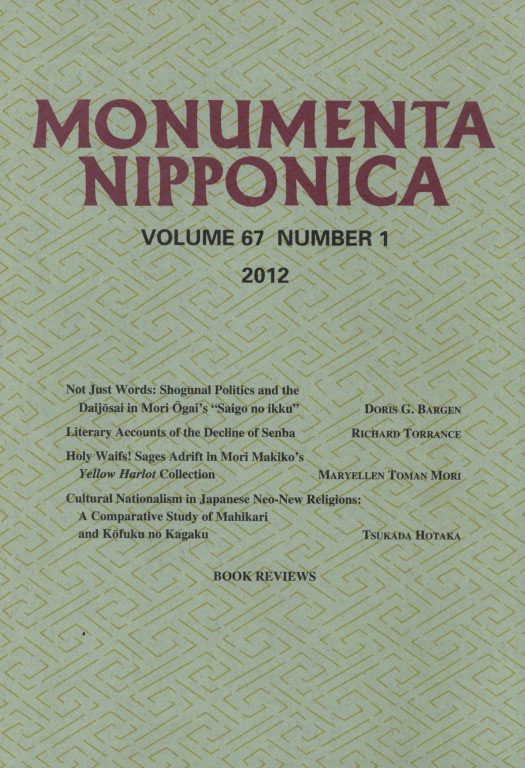 MN 67:1 (2012) 1–27Not Just Words: Shogunal Politics and the Daijōsai in Mori Ōgai’s “Saigo no ikku”Doris G. Bargen
MN 67:1 (2012) 1–27Not Just Words: Shogunal Politics and the Daijōsai in Mori Ōgai’s “Saigo no ikku”Doris G. Bargen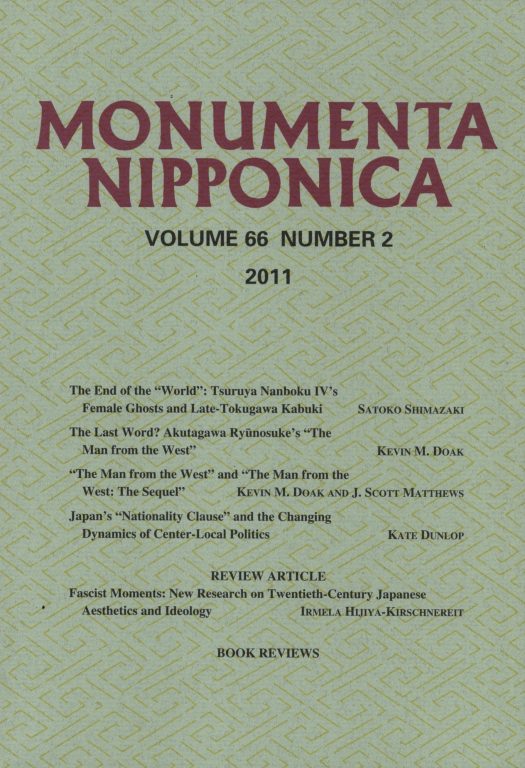 MN 66:2 (2011) 247–80The Last Word?: Akutagawa Ryūnosuke’s “The Man from the West”Kevin M. Doak
MN 66:2 (2011) 247–80The Last Word?: Akutagawa Ryūnosuke’s “The Man from the West”Kevin M. Doak MN 66:2 (2011) 257–80“The Man from the West” and “The Man from the West: The Sequel”Akutagawa Ryūnosuke, Translated by Kevin M. Doak and J. Scott Matthews
MN 66:2 (2011) 257–80“The Man from the West” and “The Man from the West: The Sequel”Akutagawa Ryūnosuke, Translated by Kevin M. Doak and J. Scott Matthews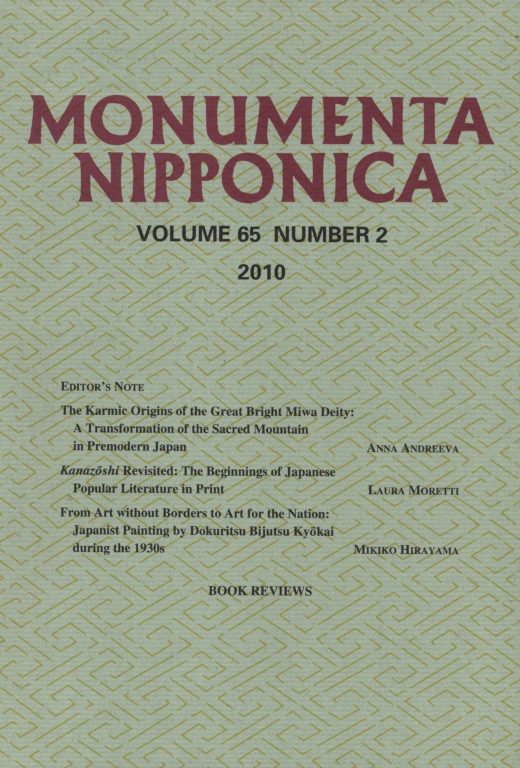 MN 65:2 (2010) 357–95From Art without Borders to Art for the Nation: Japanist Painting by Dokuritsu Bijutsu Kyōkai during the 1930s (Images)Mikiko Hirayama
MN 65:2 (2010) 357–95From Art without Borders to Art for the Nation: Japanist Painting by Dokuritsu Bijutsu Kyōkai during the 1930s (Images)Mikiko Hirayama MN 65:2 (2010) 357–95From Art without Borders to Art for the Nation: Japanist Painting by Dokuritsu Bijutsu Kyōkai during the 1930sMikiko Hirayama
MN 65:2 (2010) 357–95From Art without Borders to Art for the Nation: Japanist Painting by Dokuritsu Bijutsu Kyōkai during the 1930sMikiko Hirayama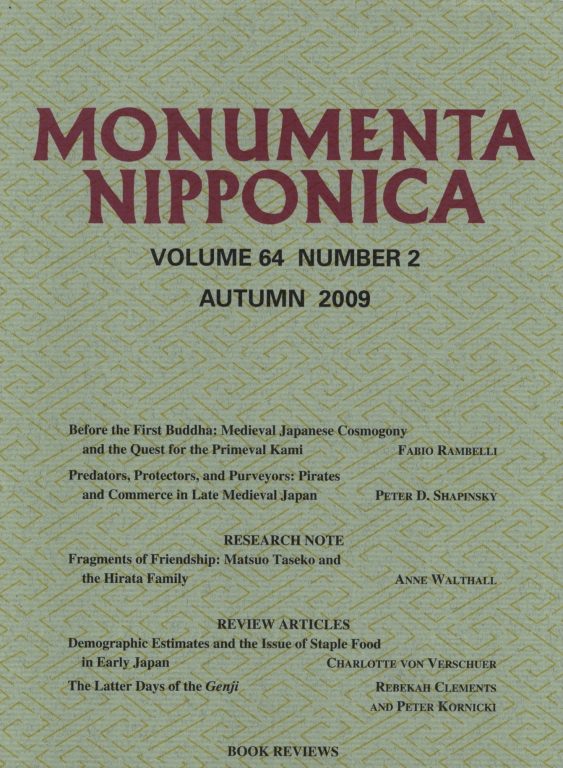 MN 64:2 (2009) 315–35Fragments of Friendship: Matsuo Taseko and the Hirata FamilyAnne Walthall
MN 64:2 (2009) 315–35Fragments of Friendship: Matsuo Taseko and the Hirata FamilyAnne Walthall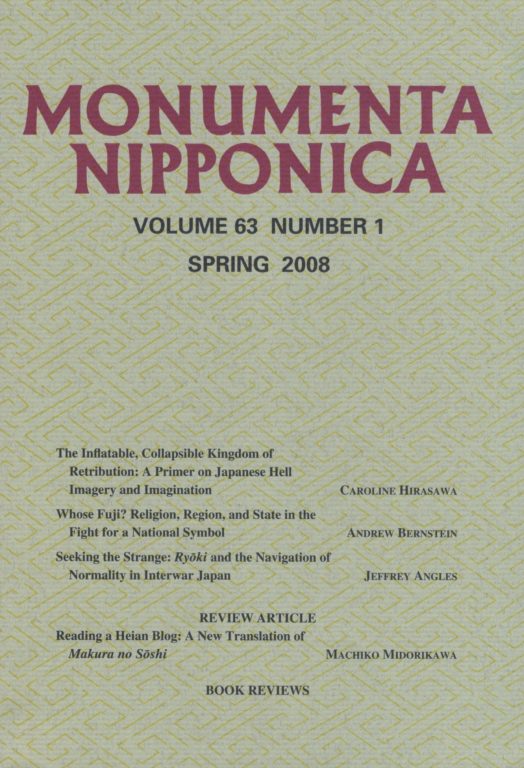 MN 63:1 (2008) 101–41Seeking the Strange: Ryōki and the Navigation of Normality in Interwar JapanJeffrey Angles
MN 63:1 (2008) 101–41Seeking the Strange: Ryōki and the Navigation of Normality in Interwar JapanJeffrey Angles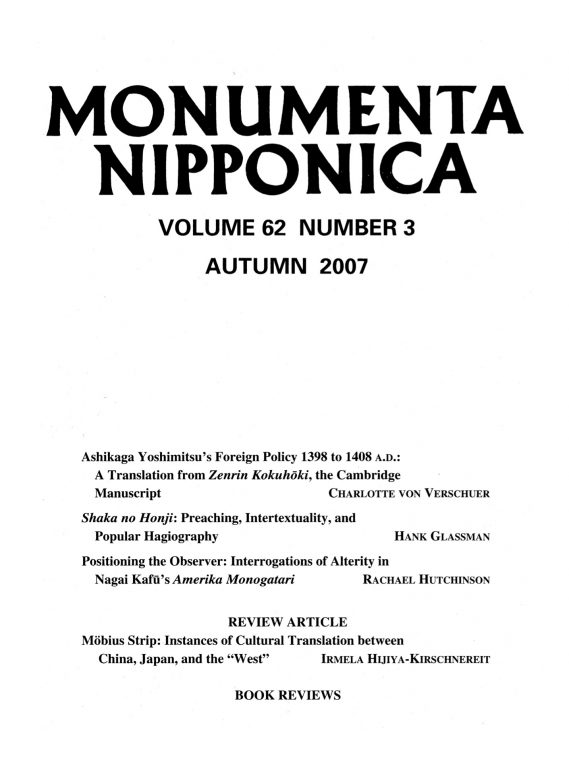 MN 62:3 (2007) 323–45Positioning the Observer: Interrogations of Alterity in Nagai Kafū’s Amerika MonogatariRachael Hutchinson
MN 62:3 (2007) 323–45Positioning the Observer: Interrogations of Alterity in Nagai Kafū’s Amerika MonogatariRachael Hutchinson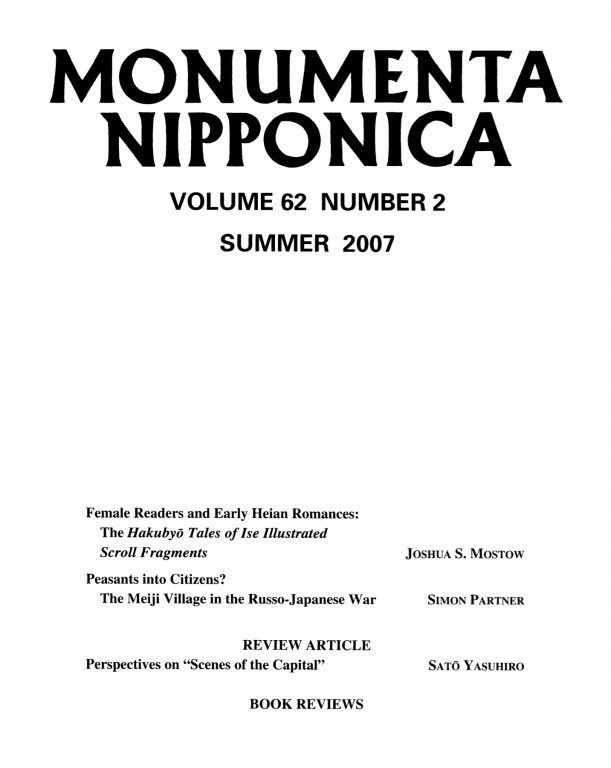 MN 62:2 (2007) 179–209Peasants into Citizens?: The Meiji Village in the Russo-Japanese WarSimon Partner
MN 62:2 (2007) 179–209Peasants into Citizens?: The Meiji Village in the Russo-Japanese WarSimon Partner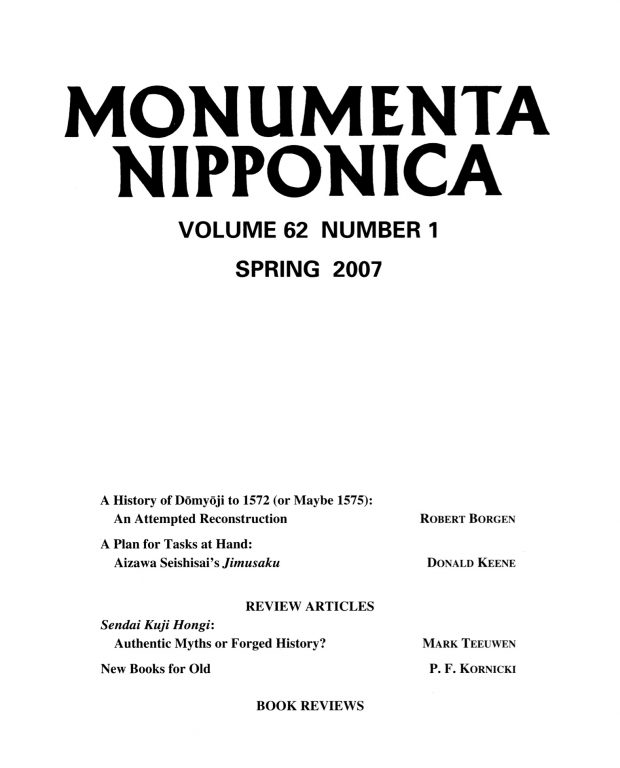 MN 62:1 (2007) 80–86A Plan for Tasks at HandAizawa Seishisai, Translated by Donald Keene
MN 62:1 (2007) 80–86A Plan for Tasks at HandAizawa Seishisai, Translated by Donald Keene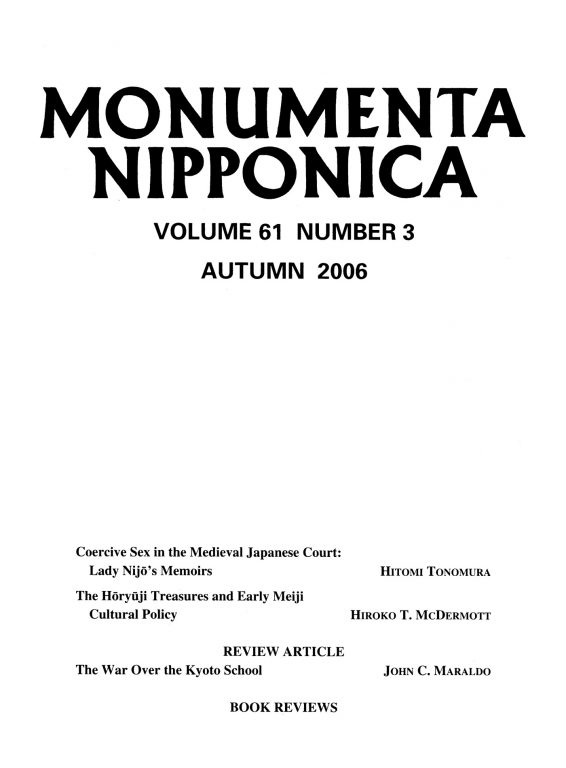 MN 61:3 (2006) 375–406The War Over the Kyoto SchoolJohn C. Maraldo
MN 61:3 (2006) 375–406The War Over the Kyoto SchoolJohn C. Maraldo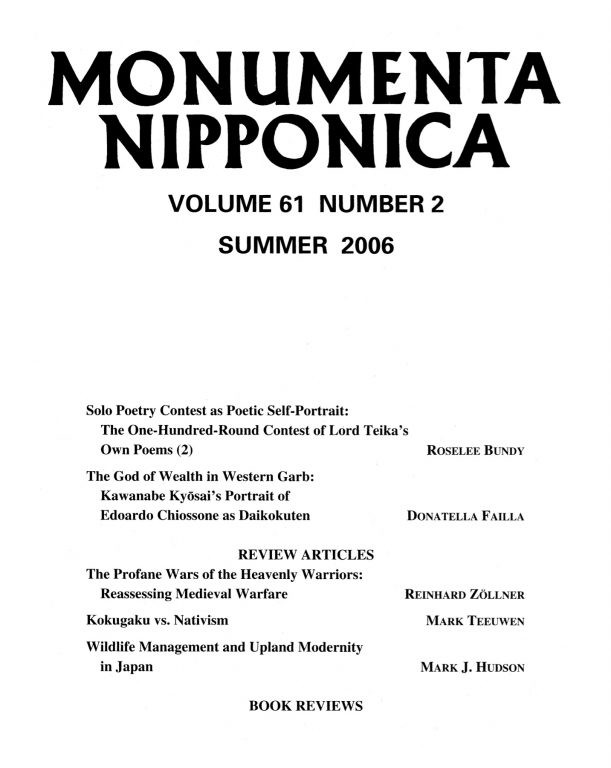 MN 61:2 (2006) 193–218The God of Wealth in Western Garb: Kawanabe Kyōsai’s Portrait of Edoardo Chiossone as DaikokutenDonatella Failla
MN 61:2 (2006) 193–218The God of Wealth in Western Garb: Kawanabe Kyōsai’s Portrait of Edoardo Chiossone as DaikokutenDonatella Failla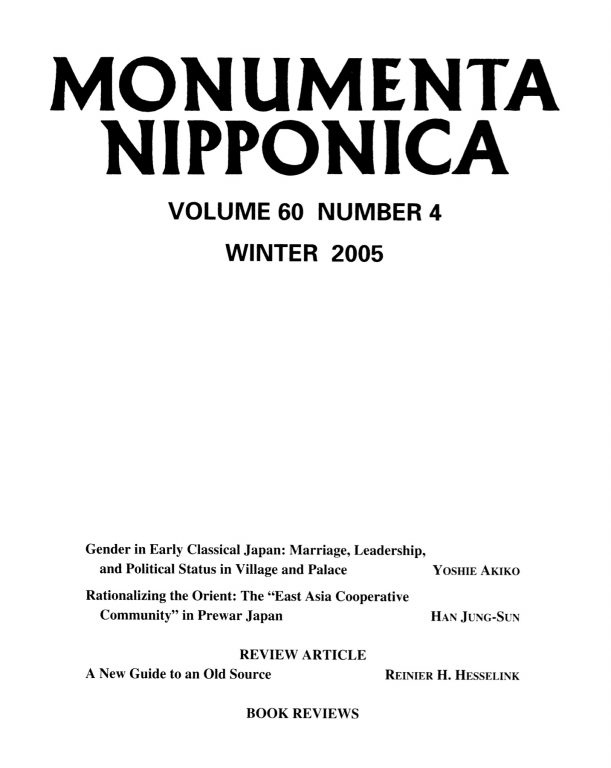 MN 60:4 (2005) 481–514Rationalizing the Orient: The “East Asia Cooperative Community” in Prewar JapanHan Jung-Sun
MN 60:4 (2005) 481–514Rationalizing the Orient: The “East Asia Cooperative Community” in Prewar JapanHan Jung-Sun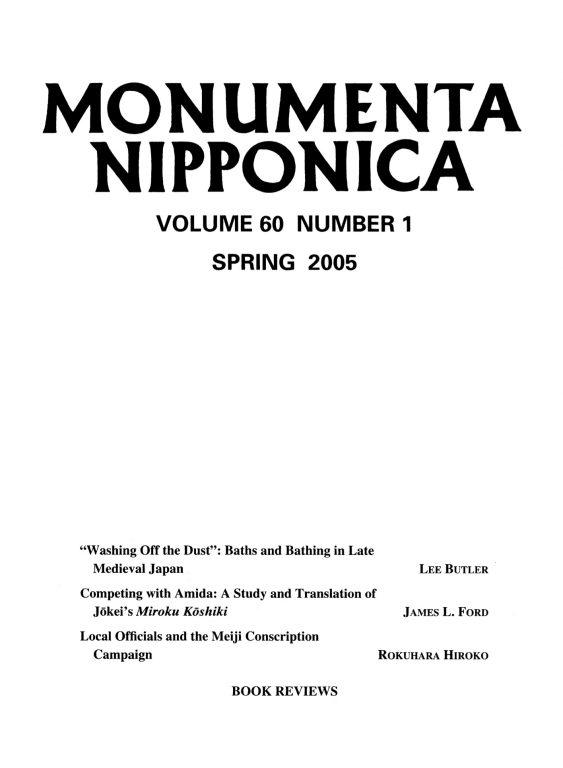 MN 60:1 (2005) 81–110Local Officials and the Meiji Conscription CampaignHiroko Rokuhara
MN 60:1 (2005) 81–110Local Officials and the Meiji Conscription CampaignHiroko Rokuhara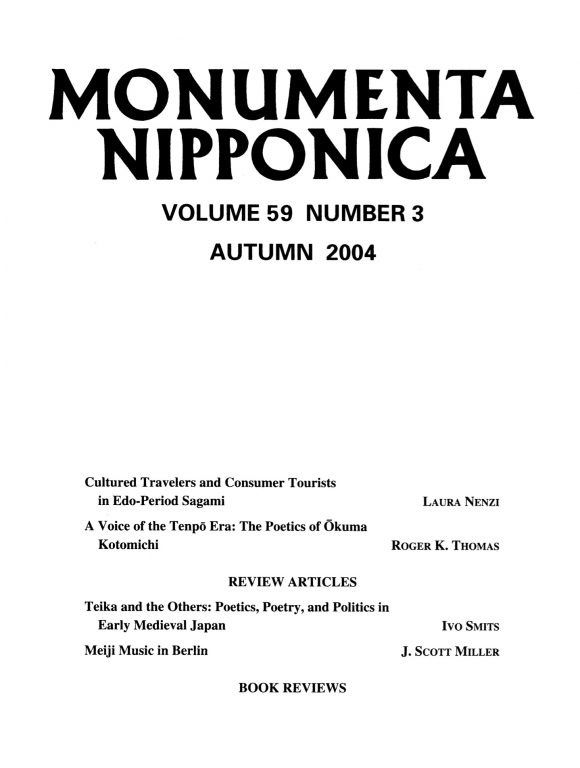 MN 59:3 (2004) 430Comment: The Iwakura Embassy in RussiaPeter F. Kornicki
MN 59:3 (2004) 430Comment: The Iwakura Embassy in RussiaPeter F. Kornicki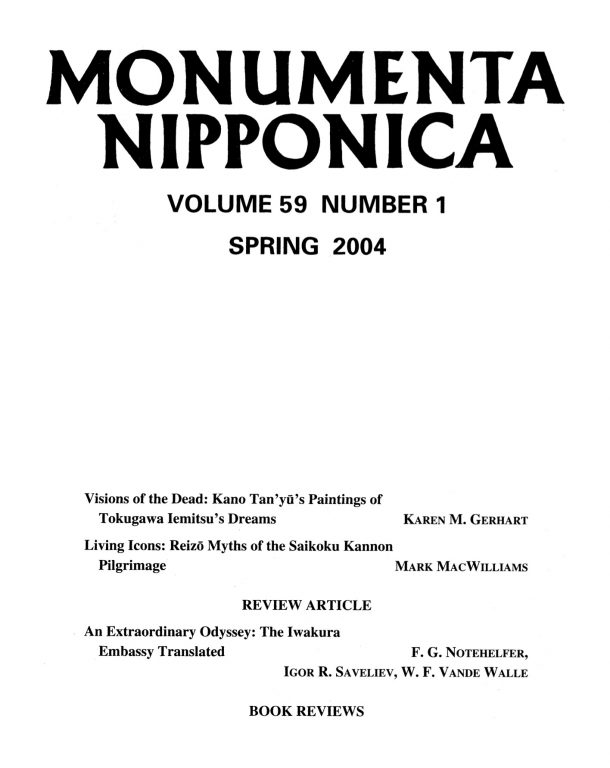 MN 59:1 (2004) 83–119An Extraordinary Odyssey: The Iwakura Embassy TranslatedF. G. Notehelfer, Igor R. Saveliev and W. F. Vande Walle
MN 59:1 (2004) 83–119An Extraordinary Odyssey: The Iwakura Embassy TranslatedF. G. Notehelfer, Igor R. Saveliev and W. F. Vande Walle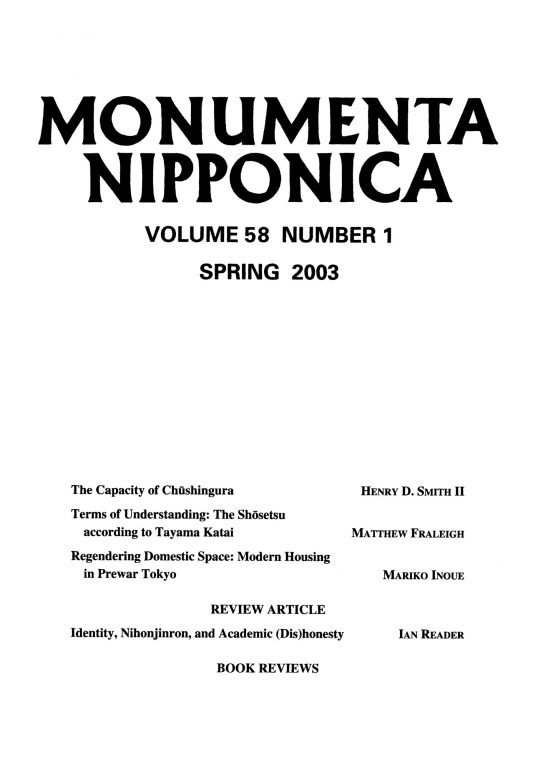 MN 58:1 (2003) 43–78Terms of Understanding: The Shōsetsu according to Tayama KataiMatthew Fraleigh
MN 58:1 (2003) 43–78Terms of Understanding: The Shōsetsu according to Tayama KataiMatthew Fraleigh MN 58:1 (2003) 79–102Regendering Domestic Space: Modern Housing in Prewar TokyoMariko Inoue
MN 58:1 (2003) 79–102Regendering Domestic Space: Modern Housing in Prewar TokyoMariko Inoue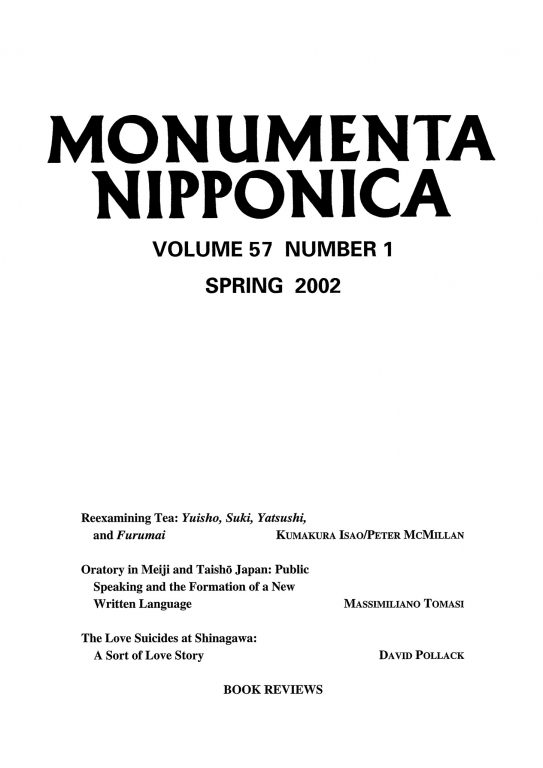 MN 57:1 (2002) 43–71Oratory in Meiji and Taishō Japan: Public Speaking and the Formation of a New Written LanguageMassimiliano Tomasi
MN 57:1 (2002) 43–71Oratory in Meiji and Taishō Japan: Public Speaking and the Formation of a New Written LanguageMassimiliano Tomasi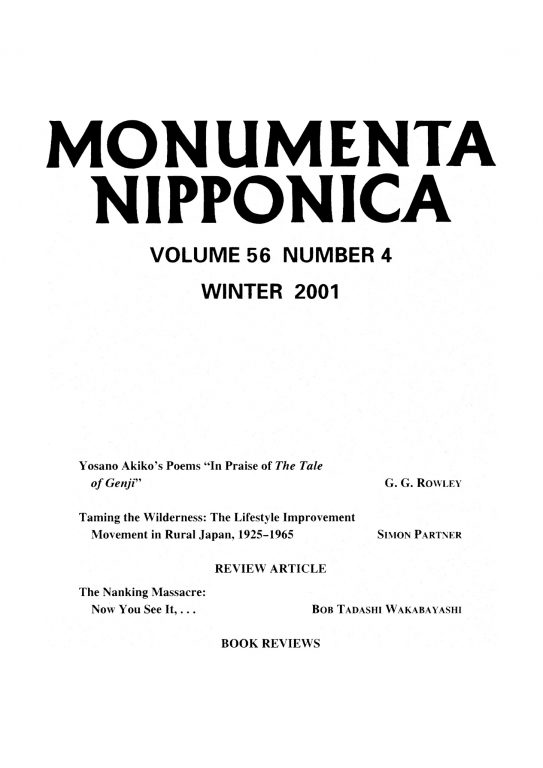 MN 56:4 (2001) 521–544The Nanking Massacre: Now You See It, . . .Bob Tadashi Wakabayashi
MN 56:4 (2001) 521–544The Nanking Massacre: Now You See It, . . .Bob Tadashi Wakabayashi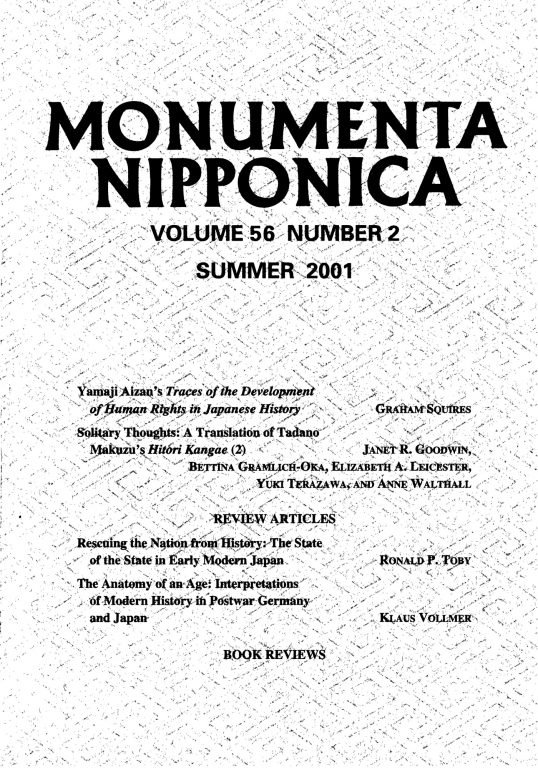 MN 56:2 (2001) 139–71Yamaji Aizan’s Traces of the Development of Human Rights in Japanese HistoryGraham Squires
MN 56:2 (2001) 139–71Yamaji Aizan’s Traces of the Development of Human Rights in Japanese HistoryGraham Squires MN 56:2 (2001) 151–71Traces of the Development of Human Rights in Japanese HistoryYamaji Aizan, Translated by Graham Squires
MN 56:2 (2001) 151–71Traces of the Development of Human Rights in Japanese HistoryYamaji Aizan, Translated by Graham Squires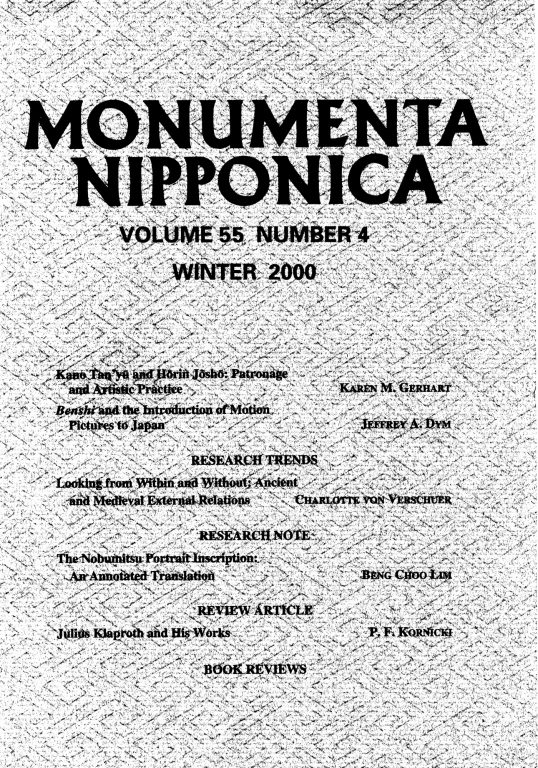 MN 55:4 (2000) 509–536Benshi and the Introduction of Motion Pictures to JapanJeffrey A. Dym
MN 55:4 (2000) 509–536Benshi and the Introduction of Motion Pictures to JapanJeffrey A. Dym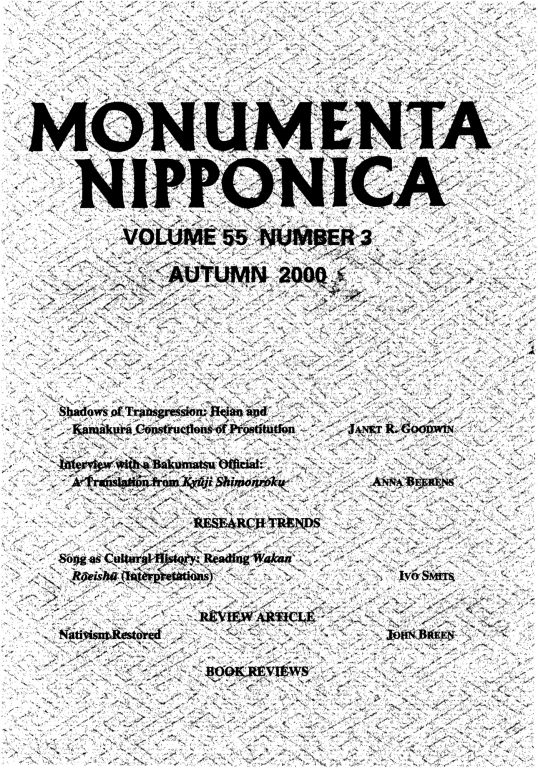 MN 55:3 (2000) 429–39Nativism RestoredJohn Breen
MN 55:3 (2000) 429–39Nativism RestoredJohn Breen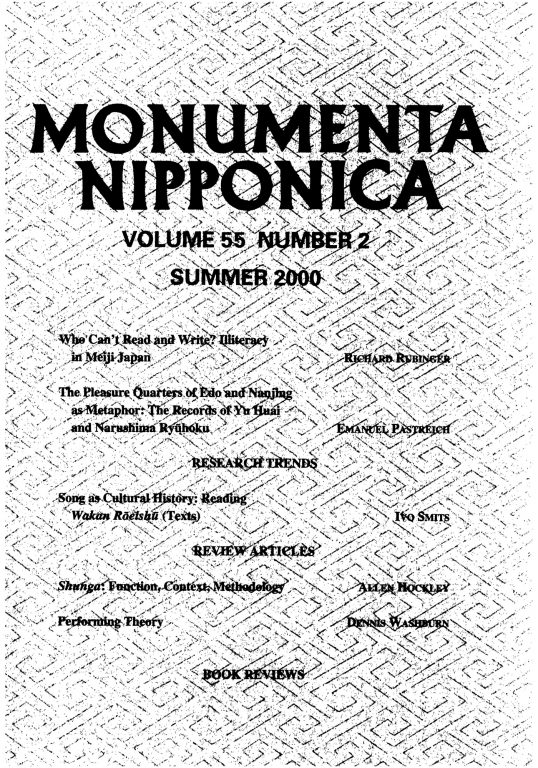 MN 55:2 (2000) 163–98Who Can’t Read and Write? Illiteracy in Meiji JapanRichard Rubinger
MN 55:2 (2000) 163–98Who Can’t Read and Write? Illiteracy in Meiji JapanRichard Rubinger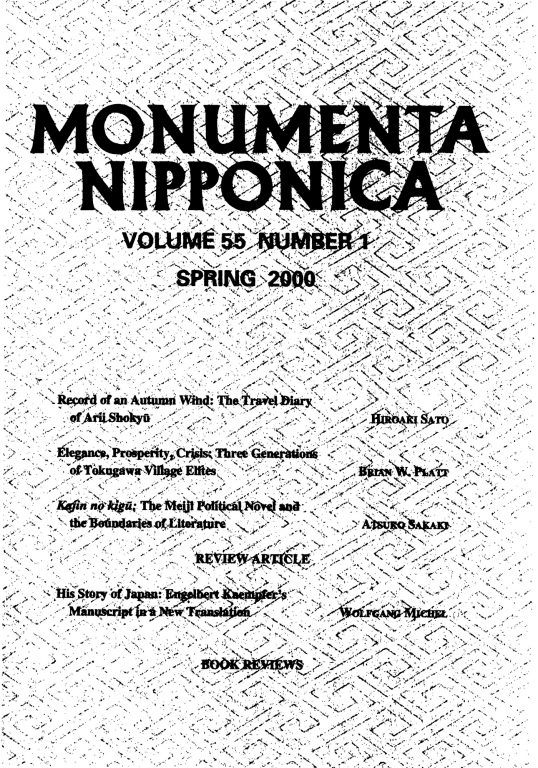 MN 55:1 (2000) 83–108Kajin no Kigū: The Meiji Political Novel and the Boundaries of LiteratureAtsuko Sakaki
MN 55:1 (2000) 83–108Kajin no Kigū: The Meiji Political Novel and the Boundaries of LiteratureAtsuko Sakaki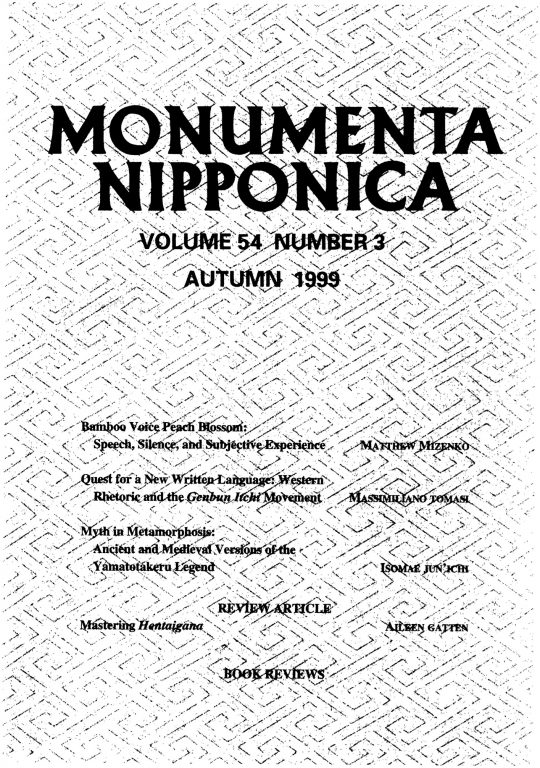 MN 54:3 (1999) 333–60Quest for a New Written Language: Western Rhetoric and the Genbun Itchi MovementMassimiliano Tomasi
MN 54:3 (1999) 333–60Quest for a New Written Language: Western Rhetoric and the Genbun Itchi MovementMassimiliano Tomasi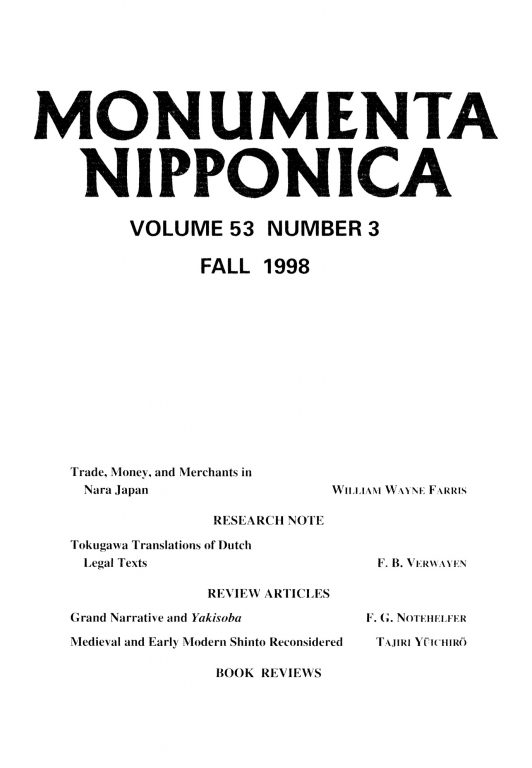 MN 53:3 (1998) 359–73From Grand Narrative to YakisobaF. G. Notehelfer
MN 53:3 (1998) 359–73From Grand Narrative to YakisobaF. G. Notehelfer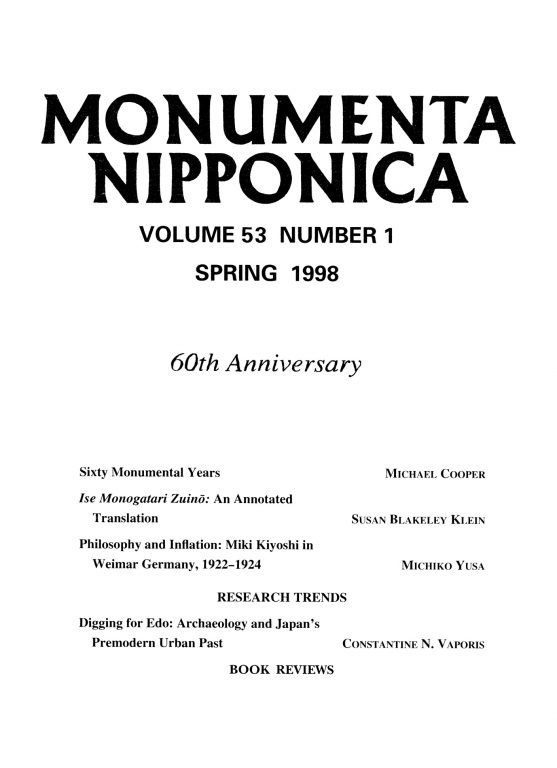 MN 53:1 (1998) 45–71Philosophy and Inflation: Miki Kiyoshi in Weimar Germany, 1922–1924Michiko Yusa
MN 53:1 (1998) 45–71Philosophy and Inflation: Miki Kiyoshi in Weimar Germany, 1922–1924Michiko Yusa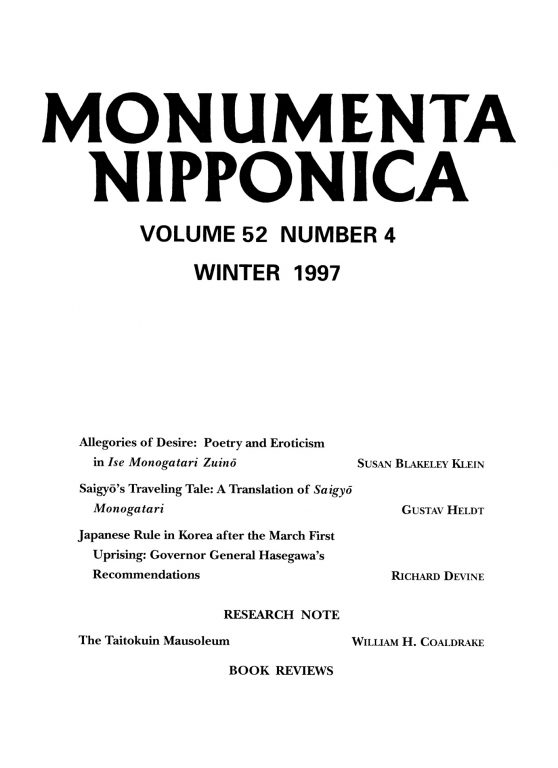 MN 52:4 (1997) 523–540Japanese Rule in Korea after the March First Uprising: Governor General Hasegawa’s RecommendationsRichard Devine
MN 52:4 (1997) 523–540Japanese Rule in Korea after the March First Uprising: Governor General Hasegawa’s RecommendationsRichard Devine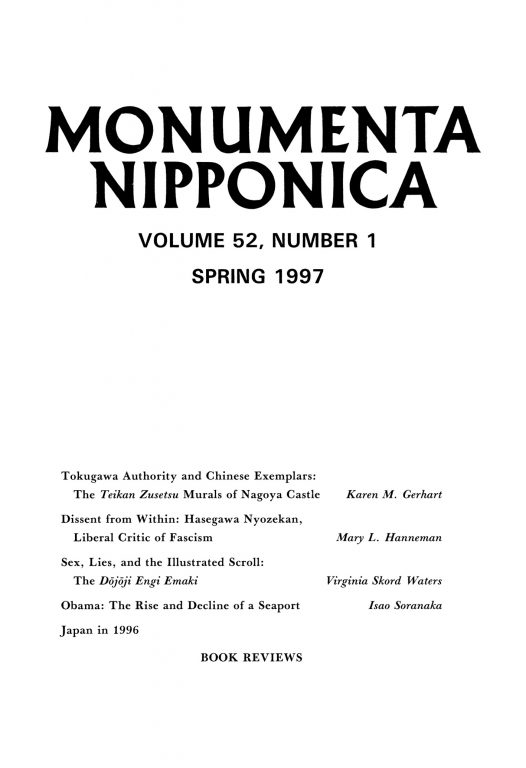 MN 52:1 (1997) 35–58Dissent from Within: Hasegawa Nyozekan, Liberal Critic of FascismMary L. Hanneman
MN 52:1 (1997) 35–58Dissent from Within: Hasegawa Nyozekan, Liberal Critic of FascismMary L. Hanneman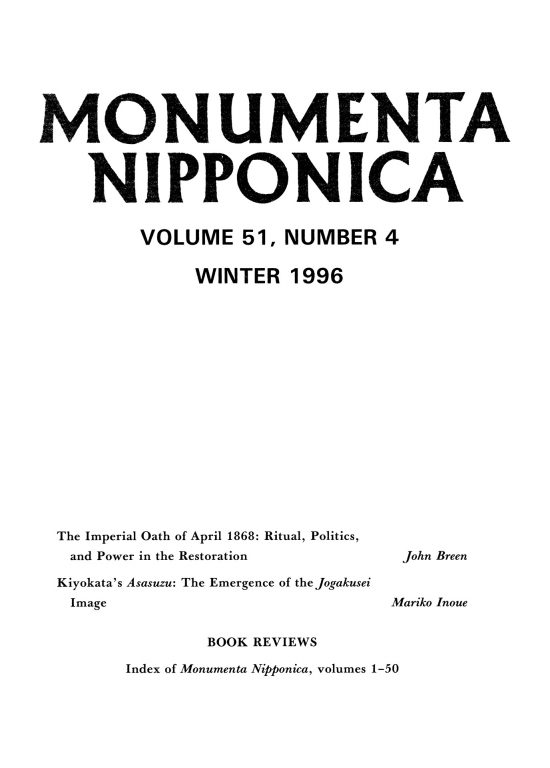 MN 51:4 (1996) 407–29The Imperial Oath of April 1868: Ritual, Politics, and Power in the RestorationJohn Breen
MN 51:4 (1996) 407–29The Imperial Oath of April 1868: Ritual, Politics, and Power in the RestorationJohn Breen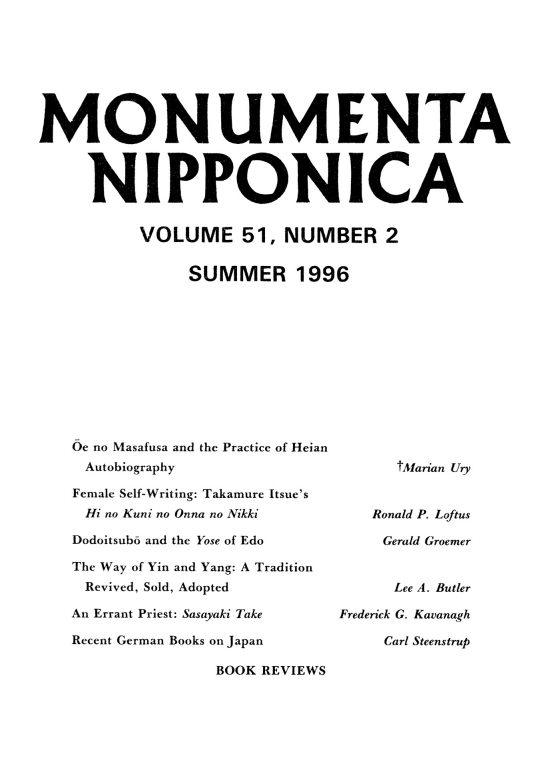 MN 51:2 (1996) 153–70Female Self-Writing: Takamure Itsue’s Hi no Kuni no Onna no NikkiRonald P. Loftus
MN 51:2 (1996) 153–70Female Self-Writing: Takamure Itsue’s Hi no Kuni no Onna no NikkiRonald P. Loftus







































